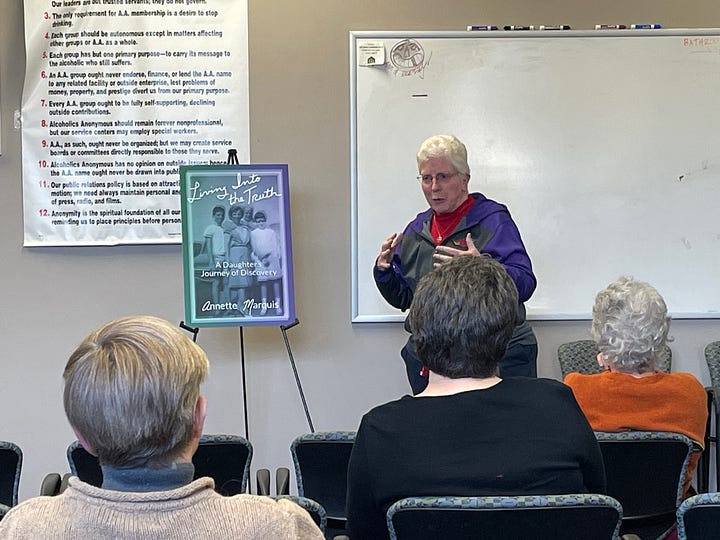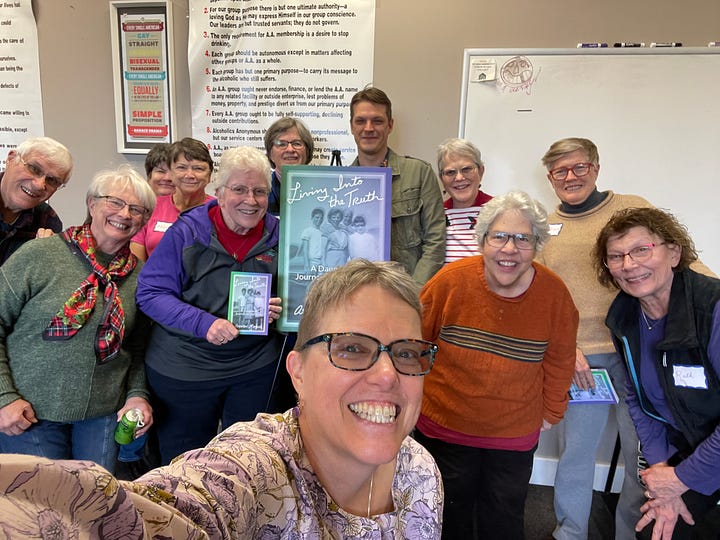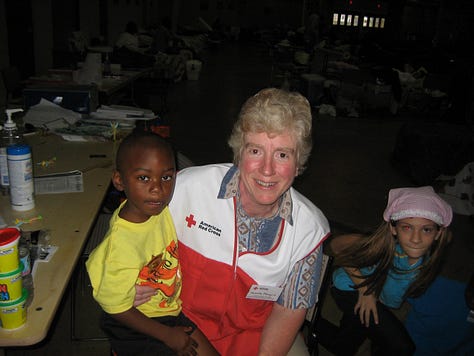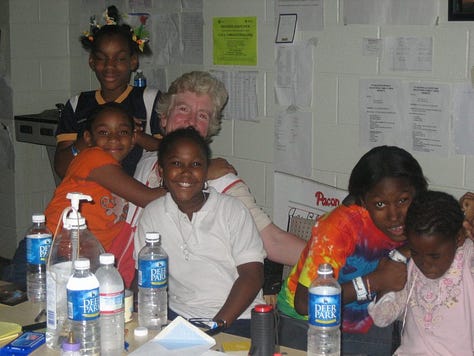Day 9: Creativity as a Path to Hope
And yes, you ARE a creative person
Dear Friends, I promised you an update on my final book launch event for Living Into the Truth: A Daughter’s Journey of Discovery (which I’m sure you’ve already purchased and read! LOL!), which was yesterday. Held at Diversity Richmond, our local LGBTQ+ community center, I focused this event on one of the two chapters in the book about marriage. In this case, “Chapter 13: Smoke and Mirrors,” when I experienced my first lesbian wedding and began to imagine a different future for myself that I had previously allowed myself to think about.
Here are some photos from the event:




All in all, it’s been a fun launch, two in-person launch parties, one Zoom event, two tables at local farm markets, and a table at a local authors library event, making six wonderful opportunities to share my story. I’m so grateful for all the folks who showed up to offer their support. Thank you!
And for those of you who couldn’t make it in person, you’re welcome to watch the video from my first launch party on November 1, 2024.
Now, on to today post.
I am not creative.
I used to think that about me. I’m too Type A, too rigid, too left-brained. I can’t draw. I don’t have the patience for crafts. I’m really not good at those types of things. My right brain shriveled up and blew away.
Telling yourself you’re not very creative is a self-fulfilling prophecy. The more you deny your creative side, the more your creative side ignores you. I can still see the photo of the cowboy my first-grade teacher, a nun at St. James School in Denver, Colorado, taped to the board at the front of our classroom.
“Draw this fellow,” she instructed. “Use your creativity and see what you can do.”
I don’t know what I drew. I’m sure, knowing me, I diligently tried to do the best I could. But I don’t remember how my cowboy turned out. I can’t even see the paper on which my drawing appeared—except, that is, for the top right corner, where Sister had placed a big red D.
I never really got over getting a D in art. It’s the only D I ever received on a paper or a class in all my years of school. Even my mom was angry about it.
“You don’t give children a D in art! she exclaimed when I admitted to her what had happened.
A couple years later, when I was in another Catholic school, this time in Rogers, Arkansas, Mom told my third-grade teacher about it and how ridiculous it was. And wouldn’t you know it, the two nuns, from different religious orders, living 750 miles apart, knew each other? They’d met at a summer program they both attended and became friends. “I’m sure she had good reason,” this nun responded.
I never drew for public consumption again. I convinced myself that I just wasn’t creative.
All through school and beyond, I’d always imagined myself as a writer, but, for much of my life, I was too scared to actually write anything. I studied writing. I read all the magazines and books about writing. In the nascent days of personal computers, I told myself that as soon as I could afford a computer, I would start writing. A typewriter just wouldn’t do anymore. But that was just an excuse. I got a computer long before most people, and I still never wrote.
It wasn’t until the mid-90s, when I got an offer to co-author a computer software book, that I started writing. I felt safe in tech writing. It’s not really creative, right? Twenty-eight tomes later, including after writing our dream series, Mastering Microsoft Office, I finally pushed myself to try some other writing.
It started with a hurricane. Somehow fitting, I think. When Hurricane Katrina devastated New Orleans and the Gulf Coast in 2005, I responded to a call to offer mental health assistance at a Red Cross shelter in Mississippi. The broken lives, the tumult in the shelter, and the resilience of the people I met conspired to inspire me to write. I started blogging at the only place in Hattiesburg that had internet access, Buffalo Wild Wings. I wrote every day. I wrote about the people and especially about the children who found themselves in a situation they didn’t understand and had no way to make sense of.



That experience convinced me that even though I still didn’t think of myself as creative, I had something worth saying and I could overcome my lack of creativity to communicate my thoughts in writing. Letting people know about what was happening was too important.
That was almost twenty years ago and since then, I’ve written for various anthologies and journals, including being invited, because of my Katrina blog, to write a chapter for The Women of Katrina: How Gender, Race, and Class Matter in an American Disaster, edited by Emmanuel David and Elaine Enarson. In 2012, I published my first book, Resistance: A Memoir of Civil Disobedience in Maricopa County, and in 2023, I started my Substack by publishing pieces from my soon-to-be-released book, Accidental Mentors; Inspirational Stories of Women Who Shaped My Life by Just Being Themselves, followed this year with the release of my memoir, Living Into the Truth.
I AM a creative person. And not just as a writer. I’m a photographer, graphic designer, and video editor/creator. No, I don’t draw or paint. I don’t knit, or crochet, or quilt. I don’t write poetry. There are many things I don’t do, but claiming those creative things I enjoy helps me know who I am. It’s helped me explore vulnerability and trust. It’s helped me understand that creativity is not limited by what we were born with. Sure, there are and always will be people who are more creative, who have natural abilities I don’t. But that doesn’t mean I can’t develop creative skills to do things they can’t.
The moral for me in all this is don’t give up on yourself. Don’t tell yourself you can’t do something. If you love it, pursue it and see where it takes you.
In times of uncertainty and despair, creativity becomes more than an outlet—it becomes a lifeline. Artistic expression offers a powerful way to channel complex emotions, process challenging experiences like the aftermath of Katrina, and envision brighter possibilities. When the world feels heavy, engaging in creative activities allows us to reconnect with a sense of purpose, beauty, and hope. It’s not about creating masterpieces; it’s about finding ways to express ourselves and imagine a better future.
The Transformative Power of Creativity
Creativity has long been intertwined with hope. Throughout history, art, music, poetry, and storytelling have been used to inspire resilience and spark change. During the Civil Rights Movement, songs like "We Shall Overcome" and “Ain’t Gonna Let Nobody Turn Me Around,” became anthems of hope and unity. In times of war, poets penned verses that carried messages of strength and survival. These creative acts weren’t just expressions of despair; they were declarations of hope in action.
At its core, creativity is an act of resistance against hopelessness. When we create, we assert that something new and meaningful can emerge from even the darkest moments. Engaging in creative activities allows us to process our emotions and translate them into forms we can see, hear, or touch. This process brings clarity and can even transform feelings of helplessness into empowerment.
Ways to Use Creativity as a Path to Hope
If you’re feeling stuck or overwhelmed, engaging in even small creative acts can help shift your perspective and ignite a sense of hope. Here are a few ideas to get started:
Journaling: Write about what hope looks like to you. If words are elusive, try creating a list of things you’re grateful for or sketching images that represent your feelings.
Art Projects: Experiment with drawing, painting, or crafting. Don’t worry about technique or skill—focus on the process of creating and expressing.
Music: Create a playlist of songs that uplift and inspire you. If you play an instrument or enjoy singing, use music as a way to channel your emotions.
Photography: Capture images that reflect beauty, resilience, or hope in your surroundings. Sometimes, the act of looking for these moments can be transformative. I know it is for me.
Nature Art: Use natural materials like leaves, stones, or flowers to create temporary art pieces that celebrate renewal and change.
These are just a few things you can do. During the pandemic, my wife created four photo books, one for each season, to remind us of what we were going through. Those books are a creative record of a significant time in our lives and in the life of the world and, I believe, will be a vital record for generations to come. That’s what creativity does. It lives after us by capturing stories (in all the many forms of story) that would otherwise be lost to history. Maybe you could turn this time around for you by capturing your feelings about it in some form for the future.
A Journey Toward Brighter Possibilities
Creativity doesn’t just help us process what is; it helps us dream about what could be. When we create, we’re actively shaping a narrative of hope, one that resists despair and embraces the potential for growth and change. Artistic expression is a testament to the resilience of the human spirit—a reminder that even in the face of darkness, we have the power to bring light.
Today’s Reflection
Think about a project you can engage over this next year that will carry you through rough times. If you’re Type A, like me, spend time developing a plan, writing an outline, or otherwise, creating a path for your journey. I swear it helps! Then, whatever your personality type, pick up a pen, a brush, a piece of fabric, some yarn, an instrument, or anything that will allow you to explore the creative side of you, and let the act of creation guide you toward hope.
With hope in my heart,
Annette






After I retired, I felt a bit adrift not being able to answer the usual question you get when meeting new people “What do you do?” Saying “I’m retired” felt like a defeat in a way, as if I no identity other than that. So I wrote a long blog post about the realization that *now* as someone out of corporate America, I can do what I want, be who I want, and so I am going to be an artist, a photographer, a scribbler of words. One of my friends (a true artist) wrote back and said “Of COURSE you’re an artist, just look at your website!” And she was right. I just hadn’t thought of “artist” as being anything other than someone who draws or paints, and I can’t do either of those well at all.
I felt the same way, for many years. I could never translate the pictures in my brain to come out through my fingers! One day, talking with my kids about my regret at not being terribly creative (both of my children are very artistic, in very different ways; lucky me!), my younger son said "But Mom, you're creative in your problem-solving skills!" I was flabbergasted, and pleased as punch!